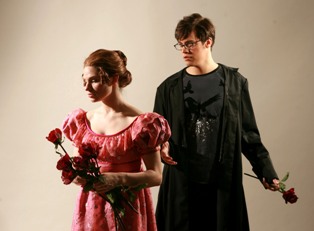
Muni's "Werther" at CCM Fraught with Beauty, Meaning

“Werther," the University of Cincinnati College-Conservatory of Music’s production of Jules Massenet’s opera that opened Thursday evening in Corbett Auditorium, has as many layers as an onion.
Make that a rose, for director Nicholas Muni’s concept, as realized by the faculty and student artists at CCM, is far more beautiful.
Muni, former artistic director of Cincinnati Opera, now distinguished artist-in-residence and associate professor of opera at CCM, calls it an “adaptation” of Massenet’s 1892 effusion about a poet (Werther) who pines to death for love of a woman he cannot have (Charlotte, who marries an older man because she promised her dying mother she would).
It is indeed an adaptation, cut by about a half-hour from its original 130-plus minutes and performed without intermission like a film. Muni draws heavily upon Goethe’s 1774, semi-autobiographical novel upon which it is based, “The Sorrows of Young Werther,” and injects bits of Freudian analysis and 20th-century theories of the unconscious as well. Adding layers upon layers, he has enlisted the images and technology of today to give it new life and relevance.
Muni presents “Werther” as universal, as relevant today as when Goethe penned his novel, as the Age of Reason was about to give way to revolution and the Romantic Movement. Werther is the eternal idealist who wants to uphold high principles in a flawed world, then discovers that the price is his own life. Charlotte represents the ideal, a pure and noble surrogate mother to her siblings, who must honor her mother’s wishes.
CCM’s update is exceedingly clever in that it doesn’t really look like it. The action transpires in the imagination of a blogger (Werther), a touch not only suggested by Goethe, who cast his novel as a series of letters to a friend, but resonates powerfully with today’s increasingly isolated, Internet culture.
Opera purists will be delighted to see the characters in gorgeous period costumes in romantic settings that would be at home in any traditional production. It unfolds behind a scrim that rises as the blogger shoots himself in despair at the end of the Overture, during which we see a mélange of projected web images and his own typed “je ne sais rien” (“I know nothing”).
Designer Thomas Umfrid’s unitary set comprises a ramp that rises from near the blogger’s station into the light (eternity?), flanked by a pair of platforms representing scenes in the opera. Projections against the back wall comment on the action, and a pair of figures in brocade (the lovers after death?) shadow Werther and Charlotte as their love takes its tragic course. Jonathan Fuchs’ lighting is magical, with radiant whites and reds and eerie dark light for the phantom figures.
Artist diploma students David Logan, tenor, and Elizabeth Pojanowski, mezzo-soprano, made a vocally and dramatically alluring couple. (Logan’s silvery timbre, range and good looks auger a bright future among his rare species.) A foil to the two, soprano Joelle Harvey sparkled as Charlotte’s younger sister Sophie, who bears her own sorrow (loving Werther) with brightness and wisdom.
Conductor Mark Gibson and the CCM Philharmonia Orchestra performed the ravishing score with precision and feeling. Repeats (with alternating casts) are 8 p.m. tonight, 2:30 p.m. Sunday in Corbett Auditorium.
(first published in The Cincinnati Post May 12, 2007)